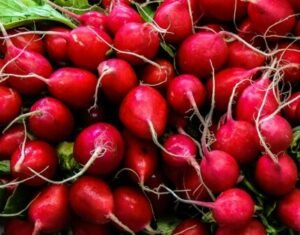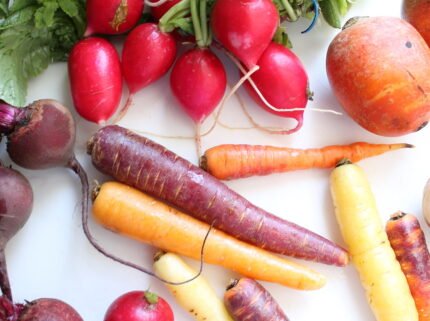Medically reviewed by Dr. Ramesh Gaddam, M.D. — Written by Sumalatha, D.N.H.E
Table of Contents
ToggleRutabaga, turnip, and radish are all root vegetables, but they have distinct characteristics in terms of taste, appearance, and culinary uses.
Rutabaga
Rutabaga, scientifically known as Brassica napus, is a root vegetable that belongs to the Brassicaceae family. It is a cross between a cabbage and a turnip, resulting from the hybridization of turnips and wild cabbage. Rutabagas are also known by various names in different regions, such as swedes or neeps in some places.
Nutrition of Rutabaga

Rutabagas are a nutritious vegetable with a variety of vitamins, minerals, and other beneficial compounds. Here is a general overview of the nutritional profile of rutabaga per 100 grams of raw, edible portion:
- Calories: Approximately 38 calories
- Water: About 89% water content
Macronutrients:
- Carbohydrates: Around 9 grams
- Dietary Fiber: Roughly 2.3 grams
- Sugars: About 5 grams
- Protein: Approximately 1 gram
- Fat: Almost negligible
Vitamins:
- Vitamin C: A good source, providing about 25 mg, or 42% of the recommended daily intake.
- Vitamin K: Contains around 1.2 micrograms, contributing to about 1.5% of the recommended daily intake.
Minerals:
- Potassium: Provides about 305 mg
- Manganese: Contains approximately 0.2 mg
- Magnesium: Around 16 mg
- Phosphorus: Approximately 38 mg
- Calcium: About 43 mg
Antioxidants:
Rutabagas contain various antioxidants, including carotenoids and flavonoids, which contribute to their overall health benefits.
Glucosinolates:
Like other cruciferous vegetables, rutabagas contain glucosinolates, which have been associated with potential health benefits, including anti-cancer properties.
Flavor and Taste of Rutabaga
The flavor and taste of rutabaga are distinctive and can be described as a mild, sweet, and slightly peppery combination. Here are some key characteristics of the flavor and taste of rutabaga:
Mildness:
Rutabaga has a milder taste compared to its close relative, the turnip. The mildness makes it versatile in the kitchen, as it can be incorporated into various dishes without overpowering other flavors.
Sweetness:
One of the notable features of rutabaga is its natural sweetness. This sweetness becomes more pronounced when the vegetable is cooked. Roasting or boiling rutabaga can enhance its natural sugars, resulting in a sweeter flavor profile.
Nutty Undertones:
Some people detect subtle nutty undertones in the flavor of rutabaga, especially when it is cooked. This adds depth and complexity to its overall taste.
Peppery Notes:
While rutabaga is generally mild, it may have a slight peppery or cabbage-like hint, particularly when consumed raw. Cooking tends to mellow out these peppery notes.
Texture:
In addition to its flavor, rutabaga has a firm and dense texture. When cooked, it becomes tender and can be mashed, roasted, or used in various culinary applications.
Versatility:
Due to its mild and sweet nature, rutabaga is versatile in the kitchen. It can be used as a side dish, mashed like potatoes, roasted, added to soups and stews, or even incorporated into casseroles.
When preparing rutabaga, consider experimenting with different cooking methods to bring out its unique flavor profile. The sweetness and mildness of rutabaga make it a valuable addition to a variety of dishes, providing both flavor and nutritional benefits.
Uses of Rutabaga
Rutabaga is a versatile vegetable that can be used in various culinary applications. Here are some common uses of rutabaga:
Mashed Rutabaga:
Cooked rutabaga can be mashed and seasoned, similar to mashed potatoes. It makes for a flavorful and nutritious alternative to traditional mashed potatoes.
Roasted Rutabaga:
Cubes or slices of rutabaga can be roasted with olive oil, herbs, and spices. Roasting enhances the natural sweetness and brings out a delicious caramelized flavor.
Soups and Stews:
Rutabaga can be diced and added to soups, stews, or chowders. Its mild flavor complements other ingredients and contributes to the overall depth of the dish.
Casseroles:
Rutabaga can be incorporated into casseroles, gratins, and baked dishes. Its sweet and nutty undertones can add complexity to the overall flavor profile of the dish.
Grilled Rutabaga:
Slice rutabaga and grill it for a unique and smoky flavor. Grilled rutabaga can be served as a side dish or added to salads.
Fried or Sautéed Rutabaga:
Thinly sliced or julienned rutabaga can be fried or sautéed. This method creates crispy rutabaga fries or a tasty side dish with a different texture.
Rutabaga Chips:
Thinly slice rutabaga, toss with olive oil and seasoning, and bake them until crispy to make rutabaga chips. A healthier alternative to potato chips.
Pickled Rutabaga:
Rutabaga can be pickled for a tangy and crunchy condiment. Pickled rutabaga can be served alongside sandwiches, salads, or as a garnish.
Rutabaga Puree:
Blend cooked rutabaga into a smooth puree, adding cream or butter for richness. This puree can be used as a side dish or incorporated into other recipes.
Rutabaga and Potato Gratin:
Layer sliced rutabaga and potatoes in a baking dish, pour a creamy sauce over them, and bake until golden brown. This creates a delicious gratin with a unique twist.
Rutabaga is a versatile vegetable, and its uses can be adapted to personal taste preferences and cultural influences. It’s a nutritious addition to various dishes, providing vitamins, minerals, and dietary fiber.
Health Benefits of Rutabaga
Rutabaga offers several health benefits due to its rich nutritional profile. Here are some of the potential health benefits associated with the consumption of rutabaga:
Nutrient-Rich:
Rutabaga is a good source of essential nutrients, including vitamin C, potassium, manganese, and dietary fiber. These nutrients play crucial roles in maintaining overall health.
Antioxidant Properties:
Rutabaga contains antioxidants, such as carotenoids and flavonoids, which help combat oxidative stress in the body. Antioxidants contribute to reducing the risk of chronic diseases and supporting overall well-being.
Vitamin C Boost:
Rutabaga is particularly high in vitamin C, an essential antioxidant that supports the immune system, promotes collagen synthesis for skin health, and helps the body absorb iron from plant-based sources.
Dietary Fiber:
The dietary fiber content in rutabaga supports digestive health by promoting regular bowel movements and preventing constipation. Fiber also helps control blood sugar levels and contributes to a feeling of fullness.
Low in Calories:
Rutabaga is a low-calorie vegetable, making it a suitable option for those looking to manage their weight while still enjoying a nutrient-dense food.
Bone Health:
Rutabaga contains minerals like calcium, phosphorus, and magnesium, which are essential for maintaining strong and healthy bones.
Heart Health:
The potassium content in rutabaga supports heart health by helping regulate blood pressure. A diet rich in potassium is associated with a lower risk of hypertension and cardiovascular diseases.
Cancer Prevention:
Rutabaga belongs to the cruciferous vegetable family, known for its potential cancer-preventive properties. It contains glucosinolates, which are compounds that may have protective effects against certain types of cancer.
Blood Sugar Regulation:
The fiber content in rutabaga, combined with its low glycemic index, may contribute to better blood sugar control. This can be beneficial for individuals with diabetes or those looking to maintain stable energy levels.
Weight Management:
Rutabaga’s low-calorie and high-fiber content make it a filling food option that can help with weight management by promoting satiety and reducing overall calorie intake.
Side Effects of Rutabaga
While rutabaga is a nutritious vegetable and generally safe for consumption, there are a few considerations regarding potential side effects for certain individuals:
Allergic Reactions:
Some individuals may be allergic to rutabaga or other vegetables from the Brassicaceae family, such as turnips or cabbage.
Allergic reactions may include symptoms like itching, swelling, hives, or difficulty breathing. If you suspect an allergy, it’s essential to seek medical attention.
Digestive Issues:
Rutabaga is a good source of dietary fiber, which can be beneficial for digestion. However, for some people, consuming too much fiber too quickly may lead to digestive discomfort, gas, bloating, or diarrhea.
It’s advisable to introduce fiber-rich foods gradually into the diet to allow the digestive system to adjust.
Goitrogenic Compounds:
Rutabaga, like other cruciferous vegetables, contains compounds known as goitrogens. These substances can interfere with thyroid function by inhibiting the absorption of iodine.
While this is typically not a concern for individuals with normal thyroid function and iodine intake, those with thyroid disorders may want to moderate their consumption of raw rutabaga or other goitrogenic foods.
Interaction with Medications:
Rutabaga, like other cruciferous vegetables, contains vitamin K. Individuals taking blood-thinning medications (anticoagulants), which require consistent vitamin K intake, should be mindful of their rutabaga consumption.
It’s advisable to consult with a healthcare professional to ensure a consistent and balanced diet.
Kidney Stones:
Rutabaga contains oxalates, which can contribute to the formation of kidney stones in susceptible individuals. Those with a history of kidney stones may need to moderate their intake of high-oxalate foods, including rutabaga.
Turnip
Turnip, scientifically known as Brassica rapa subsp. rapa, is a root vegetable belonging to the Brassicaceae family. It is a close relative of rutabaga and has been cultivated for centuries for its edible roots and greens.
Nutrition of Turnip

Turnips are a low-calorie, nutrient-dense vegetable that provides a range of vitamins, minerals, and other beneficial compounds. Here’s a general overview of the nutritional profile of turnips, based on a raw, edible portion of 100 grams:
Calories:
- Approximately 28 calories
Water Content:
- About 90% water
Macronutrients:
- Carbohydrates: Around 6.4 grams
- Dietary Fiber: Approximately 1.8 grams
- Sugars: About 3.8 grams
- Protein: Approximately 0.9 grams
- Fat: Almost negligible
- Carbohydrates: Around 6.4 grams
Vitamins:
Vitamin C: A good source, providing about 21 mg, or 35% of the recommended daily intake. Vitamin C is an antioxidant that supports the immune system and collagen production.
Vitamin K: Contains around 0.1 micrograms, contributing to about 1% of the recommended daily intake. Vitamin K is essential for blood clotting and bone health.
Minerals:
Potassium: Provides about 191 mg. Potassium is important for maintaining proper heart and muscle function, as well as fluid balance.
Folate (Vitamin B9): Contains approximately 8 micrograms, contributing to about 2% of the recommended daily intake. Folate is important for cell division and DNA synthesis.
Antioxidants:
Turnips contain various antioxidants, including carotenoids and flavonoids, which contribute to their potential health benefits.
Phytonutrients:
Turnips, like other cruciferous vegetables, contain phytonutrients such as glucosinolates. These compounds have been associated with potential health benefits, including anti-cancer properties.
Low Glycemic Index:
Turnips have a low glycemic index, which means they have a minimal impact on blood sugar levels. This makes them a suitable choice for individuals managing blood sugar levels.
Flavor and Taste of Turnip
Turnips have a distinct flavor that can be described as mildly sweet, slightly peppery, and earthy. The taste of turnips can vary depending on factors such as the specific variety, size, and growing conditions. Here are some key characteristics of the flavor and taste of turnips:
Mild Sweetness:
Young turnips, especially smaller ones, tend to have a milder and sweeter flavor. The sweetness becomes more pronounced when turnips are cooked, roasted, or caramelized.
Peppery and Earthy Notes:
Turnips possess a subtle peppery undertone, which is more noticeable when they are eaten raw. The earthy notes in the flavor profile contribute to the overall complexity of the taste.
Crunchy Texture (when raw):
Raw turnips have a crisp and crunchy texture, making them suitable for fresh consumption in salads or as crudites with dips.
Cooked Turnips:
Cooking turnips, whether by boiling, roasting, or sautéing, can mellow the peppery notes and enhance their natural sweetness. The texture becomes softer, and the flavor becomes more savory.
Versatility:
Turnips are versatile in the kitchen and can take on the flavors of other ingredients in various dishes. They are often used in soups, stews, casseroles, and roasted vegetable medleys.
Root and Greens:
While the turnip root is the main edible part, the greens (turnip tops) are also nutritious and have a slightly bitter taste. The greens can be cooked and consumed alongside the root or separately.
Balancing Other Flavors:
Turnips are known for their ability to complement and balance the flavors of other ingredients in dishes. They are commonly used as part of a flavor profile in mixed vegetable dishes.
Overall, the taste of turnips can be influenced by how they are prepared and cooked. Whether enjoyed raw for a crisp and mildly sweet experience or cooked for a softer, savory profile, turnips add a unique flavor to a variety of culinary creations.
Health Benefits of Turnip
Turnips offer several health benefits due to their rich nutritional content. Here are some potential health benefits associated with the consumption of turnips:
Low in Calories:
Turnips are low in calories, making them a suitable option for those looking to manage their weight while still enjoying a nutrient-dense food.
Rich in Nutrients:
Turnips provide essential vitamins and minerals, including vitamin C, potassium, folate, and dietary fiber. These nutrients are crucial for overall health, supporting immune function, heart health, and digestion.
High in Vitamin C:
Turnips are a good source of vitamin C, an antioxidant that helps protect cells from damage, supports the immune system, and aids in collagen production for skin health.
Dietary Fiber:
The dietary fiber in turnips contributes to digestive health by promoting regular bowel movements, preventing constipation, and supporting a healthy gut microbiome.
Low Glycemic Index:
Turnips have a low glycemic index, meaning they have a minimal impact on blood sugar levels. This can be beneficial for individuals managing diabetes or those looking to maintain stable energy levels.
Heart Health:
Potassium, present in turnips, is essential for maintaining proper heart function and regulating blood pressure. The fiber content also contributes to heart health by helping to lower cholesterol levels.
Antioxidant Properties:
Turnips contain antioxidants, such as carotenoids and flavonoids, which help combat oxidative stress and inflammation in the body. These antioxidants contribute to overall health and may help reduce the risk of chronic diseases.
Cancer Prevention:
Turnips belong to the cruciferous vegetable family, known for its potential cancer-fighting properties. The presence of glucosinolates in turnips may have protective effects against certain types of cancer.
Bone Health:
Turnips contain minerals like calcium and phosphorus, which are essential for maintaining strong and healthy bones.
Hydration:
With about 90% water content, turnips contribute to overall hydration, supporting various bodily functions, including temperature regulation and nutrient transport.
Side Effects of Turnip
While turnips are generally safe and nutritious when consumed in moderation as part of a balanced diet, there are a few considerations regarding potential side effects for certain individuals:
Allergic Reactions:
Some individuals may be allergic to turnips or other vegetables from the Brassicaceae family, such as cabbage or mustard.
Allergic reactions may include symptoms like itching, swelling, hives, or difficulty breathing. If you suspect an allergy, it’s crucial to seek medical attention.
Digestive Issues:
Turnips are a good source of dietary fiber, which is generally beneficial for digestion. However, consuming too much fiber too quickly may cause digestive discomfort, gas, bloating, or diarrhea in some individuals.
It’s advisable to introduce fiber-rich foods gradually into the diet to allow the digestive system to adjust.
Goitrogenic Compounds:
Turnips, like other cruciferous vegetables, contain compounds known as goitrogens. These substances can interfere with thyroid function by inhibiting the absorption of iodine.
While this is typically not a concern for individuals with normal thyroid function and iodine intake, those with thyroid disorders may want to moderate their consumption of raw turnips or other goitrogenic foods.
Kidney Stones:
Turnips contain oxalates, which can contribute to the formation of kidney stones in susceptible individuals. Those with a history of kidney stones may need to moderate their intake of high-oxalate foods, including turnips.
Interaction with Medications:
Turnips, like other vegetables rich in vitamin K, can interfere with blood-thinning medications (anticoagulants) that require consistent vitamin K intake.
Individuals taking such medications should maintain a consistent intake of vitamin K and consult with their healthcare provider for dietary guidance.
Flatulence:
The presence of certain carbohydrates in turnips may lead to increased gas production in some individuals, causing flatulence or bloating.
Radish
Radishes are crisp, colorful vegetables that belong to the Brassicaceae family, which also includes cabbage, broccoli, and mustard. They are known for their distinct peppery flavor and vibrant hues.
Nutrition of Radish

Radishes are low in calories and rich in vitamins, minerals, and antioxidants. Here’s a general overview of the nutritional profile of radishes, based on a raw, edible portion of 100 grams:
Calories: Approximately 16 calories
Water Content: About 95% water, contributing to hydration.
Macronutrients:
Carbohydrates: Around 3.4 grams
Dietary Fiber: Approximately 1.6 grams
Sugars: About 1.9 grams
Protein: Approximately 0.7 grams
Fat: Almost negligible
Vitamins:
Vitamin C: A good source, providing about 14 mg, or 23% of the recommended daily intake. Vitamin C is an antioxidant that supports the immune system and helps with collagen production for skin health.
Folate (Vitamin B9): Contains approximately 25 micrograms, contributing to about 6% of the recommended daily intake. Folate is important for cell division and DNA synthesis.
Minerals:
Potassium: Provides about 233 mg. Potassium is essential for maintaining proper heart and muscle function, as well as fluid balance.
Phosphorus: Contains approximately 20 mg.
Magnesium: Around 10 mg.
Calcium: About 25 mg.
Antioxidants:
Radishes contain various antioxidants, including carotenoids and flavonoids. These compounds contribute to the potential health benefits associated with the consumption of radishes.
Phytonutrients:
Radishes, like other cruciferous vegetables, contain phytonutrients such as glucosinolates. These compounds have been associated with potential cancer-fighting properties.
Low Glycemic Index:
Radishes have a low glycemic index, meaning they have a minimal impact on blood sugar levels. This makes them a suitable choice for individuals managing diabetes or those looking to maintain stable energy levels.
Flavor and Taste of Radish
Radishes are known for their distinctive flavor, which can be described as peppery, slightly spicy, and crisp. The taste of radishes is influenced by various factors, including the specific variety, size, and growing conditions. Here are some key characteristics of the flavor and taste of radishes:
Peppery and Spicy:
Radishes have a peppery and spicy kick, particularly when eaten raw. This peppery quality is due to compounds like glucosinolates and isothiocyanates, which contribute to the distinct flavor.
Crunchy Texture:
Radishes have a crisp and crunchy texture, especially when fresh. This makes them a popular choice for salads, as they add a refreshing and textural element.
Varietal Differences:
Different varieties of radishes can exhibit variations in flavor. For example, red radishes tend to have a milder taste compared to daikon radishes, which are larger and have a more pronounced peppery flavor.
Mildness with Cooking:
Cooking radishes, such as roasting or sautéing, can mellow their peppery notes and introduce a slightly sweet undertone. The heat softens the radishes and alters their flavor profile.
Watermelon Radishes:
Some varieties, like watermelon radishes, have a mild and subtly sweet taste with vibrant pink or red interiors. These radishes are known for their striking appearance and are often used for both visual appeal and flavor in dishes.
Complements Other Flavors:
Radishes are versatile and can complement a variety of flavors in dishes. They pair well with salads, sandwiches, and appetizers, adding a zesty and refreshing element.
Radish Greens:
The greens (leaves) of radishes are also edible and have a slightly bitter taste. They can be used in salads, sautéed, or added to soups for added flavor and nutrition.
Quick Pickling:
Radishes can be pickled quickly with vinegar, salt, and sugar, providing a tangy and flavorful condiment.
The flavor and taste of radishes can be influenced by personal preferences and culinary techniques. Whether enjoyed raw for a peppery crunch, cooked for a milder flavor, or pickled for a tangy twist, radishes add a unique and refreshing element to a variety of dishes.
Health Benefits of Radish
Radishes offer a range of health benefits due to their rich nutritional profile. Here are some potential health benefits associated with the consumption of radishes:

Low in Calories:
Radishes are low in calories and can be a satisfying and nutritious addition to a calorie-conscious diet.
Rich in Antioxidants:
Radishes contain antioxidants, including vitamin C, which help combat oxidative stress and inflammation in the body. Antioxidants play a role in reducing the risk of chronic diseases.
Supports Digestive Health:
Radishes are a good source of dietary fiber, which promotes regular bowel movements, prevents constipation, and supports a healthy digestive system.
Hydration:
With a high water content (about 95%), radishes contribute to hydration, helping maintain proper bodily functions and supporting overall health.
Vitamin C Boost:
Radishes are a good source of vitamin C, an essential nutrient that supports the immune system, aids in collagen production for skin health, and acts as an antioxidant.
Heart Health:
The potassium content in radishes contributes to heart health by helping regulate blood pressure. Potassium is essential for proper heart and muscle function.
Cancer Prevention:
Radishes belong to the cruciferous vegetable family, known for its potential cancer-fighting properties. Compounds like glucosinolates found in radishes may have protective effects against certain types of cancer.
Blood Sugar Regulation:
Radishes have a low glycemic index, which means they have a minimal impact on blood sugar levels. This makes them a suitable choice for individuals managing diabetes or those looking to maintain stable energy levels.
Weight Management:
Radishes are low in calories and high in water and fiber, contributing to a feeling of fullness. Including radishes in meals may help with weight management by reducing overall calorie intake.
Bone Health:
Radishes contain minerals such as calcium and phosphorus, which are essential for maintaining strong and healthy bones.
Side Effects of Radish
While radishes are generally safe and nutritious for most people when consumed in moderation, there are a few considerations regarding potential side effects for certain individuals:

Allergic Reactions:
Some individuals may be allergic to radishes or other vegetables from the Brassicaceae family, such as cabbage or mustard.
Allergic reactions may include symptoms like itching, swelling, hives, or difficulty breathing. If you suspect an allergy, it’s crucial to seek medical attention.
Digestive Issues:
Radishes are a good source of dietary fiber, which is generally beneficial for digestion. However, consuming too many radishes, especially if unaccustomed to a high-fiber diet, may lead to digestive discomfort, gas, bloating, or diarrhea.
It’s advisable to introduce fiber-rich foods gradually into the diet to allow the digestive system to adjust.
Interaction with Thyroid Medications:
Radishes, like other cruciferous vegetables, contain compounds known as goitrogens. These substances can interfere with thyroid function by inhibiting the absorption of iodine.
While this is typically not a concern for individuals with normal thyroid function and iodine intake, those with thyroid disorders may want to moderate their consumption of raw radishes or other goitrogenic foods.
Kidney Stones:
Radishes contain oxalates, which can contribute to the formation of kidney stones in susceptible individuals. Those with a history of kidney stones may need to moderate their intake of high-oxalate foods, including radishes.
Gastroesophageal Reflux Disease (GERD):
The spiciness of radishes may exacerbate symptoms of GERD in some individuals. Those prone to acid reflux may want to monitor their intake and observe how radishes affect their symptoms.
Blood Sugar Levels:
While radishes have a low glycemic index, individuals with diabetes should still monitor their blood sugar levels when consuming radishes, especially in large quantities.
Conclusion
In conclusion, rutabaga, turnip, and radish are all root vegetables belonging to the Brassicaceae family, each with its own distinct characteristics in terms of appearance, flavor, and nutritional content.

Rutabaga:
Rutabaga is a larger, bulbous vegetable with a tan or brownish exterior and yellowish flesh. It has a mild, sweet flavor with nutty undertones.
Rutabaga is versatile in the kitchen and can be mashed, roasted, or used in various dishes. It is rich in nutrients, including vitamin C, potassium, and dietary fiber.
Turnip:
Turnip is a smaller, round or cylindrical vegetable with a white, red, or purple skin and white flesh. It has a slightly peppery and earthy flavor, and its taste can vary based on the variety and size.
Turnips can be consumed raw, cooked, mashed, or pickled. They are low in calories and provide essential nutrients such as vitamin C, potassium, and dietary fiber.
Radish:
Radish is a crisp and colorful vegetable with a peppery and slightly spicy flavor. Radishes come in various varieties, including red, white, and watermelon radishes.
They are commonly eaten raw in salads, providing a crunchy texture and a zesty kick. Radishes are low in calories and high in vitamin C, potassium, and antioxidants.
Each of these root vegetables can be a nutritious addition to a well-balanced diet, offering unique flavors and textures. They can be enjoyed in various culinary applications, from raw snacks and salads to cooked dishes, soups, and stews.
While they share some similarities, the differences in taste, appearance, and nutritional content make them versatile ingredients that can add diversity to meals.
When incorporating these vegetables into your diet, consider personal preferences, culinary preferences, and any specific dietary or health considerations.
Medically reviewed by Dr. Ramesh Gaddam, M.D.

General Physician, Diabetologist, and Critical Care Specialist.
Related
Discover more from Health Build-Up
Subscribe to get the latest posts sent to your email.
